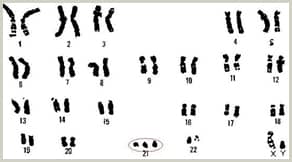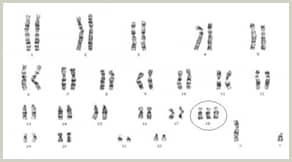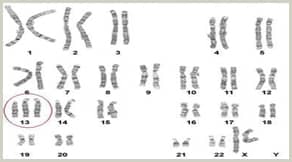The Syndromes

Down syndrome is the most common condition caused by the presence of an irregular number of chromosomes in each cell.
Alternative names: Trisomy 21, Down's syndrome
Manifestations of Down syndrome
Down syndrome is typically associated with mental retardation, and individuals with the condition (often erroneously termed "Mongoloids") usually display IQs of between 20 and 85. The syndrome is also characterized by physical features such as a broad forehead, slightly oblique eyes, a larger-than-normal tongue, shortened limbs and a short stature. In addition, individuals with Down syndrome often suffer from related medical conditions such as sight and hearing disorders, congenital heart disease and digestive tract problems. Although life expectancy among people with Down syndrome is relatively low, at around 49 years, it has increased markedly in recent years following improvements in medical care.
What causes the condition?
The direct cause of the syndrome, as aforesaid, is the presence of an irregular number of chromosomes in each cell. A normal fetus has 44 chromosomes – 22 from the mother and 22 from the father – plus two gender chromosomes: X and Y in a male fetus, and X and X in a female fetus. A healthy fetus, therefore, has 46 chromosomes arranged in 23 pairs. With Down syndrome, however, the fetus has 47 chromosomes, with chromosome 21 appearing three times rather than as a pair.
Is there a link between Down syndrome and the age of the mother?
The older a woman is when she gets pregnant, the higher the risk of a fetus with an irregular number of chromosomes – and thus the higher the risk of Down syndrome. For example, at age 25, the risk is approximately 1 : 1,300; at 35, this risk increases to 1 : 400 and higher.

Edwards syndrome is the second most common condition (after Down syndrome) that is caused by an irregular number of chromosomes in each cell.
Alternative names: Trisomy 18, Edwards' syndrome
Manifestations of Edwards syndrome
Edwards syndrome causes severe mental retardation along with heart and kidney defects. In addition, physical malformations associated with the condition include a relatively small head, an abnormally small and distinctly shaped jaw, clenched hands, loose skin and others. The life expectancy of fetuses and babies with Edwards syndrome is very low: The majority of fetuses will die before birth and a very small percentage of infants survive beyond a few years.
What causes the condition?
The direct cause of the syndrome, as aforesaid, is the presence of an irregular number of chromosomes in each cell. A healthy fetus has 46 chromosomes in each cell – 23 from the father and 23 from the mother. With Edwards syndrome, however, the fetus has 47 chromosomes, with chromosome 18 appearing three times rather than as a pair (hence the name, Trisomy 18).
Is there a link between Edwards syndrome and the age of the mother?
The older a woman is when she gets pregnant, the higher the risk of a fetus with an irregular number of chromosomes – and thus the higher the risk of Edwards syndrome

Patau syndrome is the third most common condition (after Down syndrome and Edwards syndrome) caused by the presence of an irregular number of chromosomes in each cell.
Alternative names: Trisomy 13, Patau's syndrome
Manifestations of Patau syndrome
Patau syndrome is associated with severe mental retardation, as well as acute heart and kidney defects. Physical malformations associated with the condition include a small head, small eyes, extra digits on the hands or feet, and more. The life expectancy of fetuses and babies with Patau syndrome is very low: The majority of fetuses will die before birth and most infants will survive for just a few days. The syndrome is more prevalent in females; male fetuses affected with the syndrome usually don't survive through the pregnancy.
What causes the condition?
The cause of Trisomy 13, as aforesaid, is the presence of an irregular number of chromosomes in each cell. Each cell of a healthy fetus contains 46 chromosomes divided into 23 pairs. Each pair includes one chromosome from the mother and one from the father. With Patau syndrome, however, the fetus has 47 chromosomes in each cell, with chromosome 13 appearing three times rather than as a pair. Note, Patau syndrome occurs in varying degrees of severity because sometimes only part of chromosome 13 becomes attached to another chromosome, thus the trisomy is partial.
Is there a link between Patau syndrome and the age of the mother?
The older a woman is when she gets pregnant, the higher the risk of a fetus with an irregular number of chromosomes – and thus the higher the risk of Patau syndrome
Turner syndrome (XO)
Turner syndrome is caused by a missing or incomplete X chromosome in females, and many of the characteristics of the condition therefore are associated with the reproductive system. The external sexual organs in most women with Turner syndrome develop normally, but non-working ovaries results in sterility. In addition, women with Turner syndrome are relatively short and also display other typical physical characteristics such as webbed necks, broad chests and widely spaced nipples, and cubitus valgus, a deformity in which the forearm is angled away from the body to a greater degree than normal when fully extended. From a health perspective, these women tend to develop high blood pressure and may also suffer from hearing loss, congenital heart disease, a tendency to develop diabetes in adulthood and more. Turner syndrome does not typically impair cognition and most sufferers have normal IQs and good verbal skills; however, learning difficulties in certain areas (spatial perception and mathematical calculations) are quite common.
Klinefelter syndrome (XXY)
Klinefelter syndrome is caused by at least one extra X chromosome in men (XXY instead of XY). Affected individuals typically suffer from fertility problems and may be completely sterile, depending on the severity of the genetic disorder (sometimes the disorder does not appear in all of the cells). Most men with the syndrome manage to lead relatively normal and healthy lives, despite the fact that they are usually very tall. In addition, they have relatively little body and facial hair and smaller-than-normal testicles. Also, the distribution of their body fat is more typical of fat-distribution in women; and as a result, affected individuals sometimes display a concentration of fat in the breasts. From a cognitive point of view, sufferers may exhibit learning difficulties, primarily insofar as language skills are concerned. Individuals with Klinefelter syndrome are also at a higher risk when it comes to various types of cancer (including breast cancer), osteoporosis and certain autoimmune disorders.
Triple X syndrome (XXX)
Triple X syndrome is caused by the presence of an extra X chromosome in each cell of a human female (XXX instead of XX). Unlike in most other chromosomal disorders, there is usually no distinguishable difference to the naked eye between women with Triple X and the rest of the female population, although sufferers tend to be relatively tall and have relatively small heads; some may also display vertical skinfolds that can cover the inner corners of the eyes. In many instances, women with Triple X syndrome suffer from learning disabilities and delayed development insofar as language skills and motor-coordination are concerned. Their IQ levels are normal, but usually 10-15 points below average (a relatively small difference that can occur also without the syndrome).
Super Male syndrome (XYY)
Super Male syndrome is caused by an extra Y chromosome in males (XYY instead of XY). The syndrome has no significant manifestations, with some medical geneticists even questioning whether the condition should be termed a syndrome. Nevertheless, men with Super Male syndrome have been found to be taller than normal and to have slightly below-average IQs. Some may suffer from learning disabilities during adolescence and can be slightly less fertile than normal. In the past, the syndrome was associated with aggression and a tendency towards violence, but current professional literature rejects this perception.
The accuracy rate of the NIFTY test for the syndromes mentioned above is being studied, however has yet to be determined.
In addition to the most common disorders, Down syndrome (Trisomy 21), Edwards syndrome (Trisomy 18) and Patau syndrome (Trisomy 13), the NIFTY test can also detect trisomies in additional chromosomes (rare trisomies found so far in chromosomes 5, 7, 8, 9, 16 and 22), mosaicism (fetuses characterized with trisomic cells, as well as normal cells) and also chromosomal deletions and duplications of 10MB or larger (the size of approximately one tenth of an average chromosome). These rare syndromes include Cri du chat syndrome, Cat Eye Syndrome, 1p36 deletion syndrome and 2q33.1 deletion syndrome.
Cri du chat syndrome
The name of this syndrome is a French term meaning "cat-cry" or "call of the cat". This is a rare syndrome (frequency between 1: 20,000 and 1:50,000 births) caused by a deletion of a small part of chromosome 5. The French term refers to the characteristic cat-like cry of affected babies. Other symptoms may include: low birth weight and poor growth, various developmental alterations, behavioral deficiencies, unusual facial features and more.
1p36 deletion syndrome
A syndrome which is caused by a deletion of a small part of chromosome 1. It occurs approximately one in every 10,000 to 5,000 births. The syndrome is characterized by moderate to severe intellectual disability as well as morphological abnormalities, vision impairment, hearing loss and epileptic seizures.
2q33.1 deletion syndrome
A syndrome which stems from a deletion of a small part of chromosome 2. The syndrome is characterized by intellectual disability of variable severity. Additional symptoms may include various neurological complications, micrognathia, ear deformities and cleft palate.
DiGeorge Syndrome 2 (10p14)
DiGeorge Syndrome is caused by small deletion in chromosome 22. It occurs approximately 1 in every 4,000 births. The severity of the syndrome depends partly on the deleted sequence's length. Symptoms may include: congenital heart disease, cleft palate and congenital brain defects.
Angelman Syndrome
The syndrome stems from a deletion of a small part of chromosome 15, which is of maternal origin. It is usually characterized by microcephaly, epilepsy, balance disorder and severe intellectual disability.
Prader-Willi Syndrome
The syndrome stems from a deletion of a small part of chromosome 15, which is of paternal origin. Symptoms may include swallowing difficulties during infancy, leading to problematic weight gaining. At later stages however, over-eating may lead to obesity. In addition, various developmental delays may appear.
Van der Woude
The syndrome is caused by a mutations in the IRF6 gene in chromosome 1. The syndrome is characterized by cleft lip, cleft palate and lip pits. This disorder is the most common syndromic form of cleft lip or palate.
Jacobsen Syndrome
The syndrome is caused by a terminal deletion of the long arm of chromosome 11. The syndrome might involve developmental delay, impaired motor function and speech disorder. Common symptoms may include cognitive deficit and learning disabilities.
16p12.2 Deletion
This microdeletion is characterized by different clinical findings, which are not characteristic of a recognizable specific syndrome. Common findings include: developmental delay, cognitive impairment, growth impairment, congenital heart disease, epilepsy and behavioral problems.
The accuracy rate of the NIFTY test for the syndromes mentioned above is being studied, however has yet to be determined.